Quantifying Surface Coal-Mining Patterns to Promote Regional Sustainability in Ordos, Inner Mongolia
Abstract
:1. Introduction
2. Study Area and Data
2.1. Study Area
2.2. Data
3. Methods
3.1. Extracting the Surface Coal-Mining Areas (SCMAs)
3.2. Quantifying the Spatiotemporal Patterns of SCMAs
4. Results
4.1. Accuracy Assessment
4.2. Spatial Patterns of SCMAs in the Ordos Region
4.3. Dynamics of SCMAs in the Ordos Region from 1990 to 2015
4.4. Socioeconomic Impacts of Surface Coal Mining
4.5. Loss of Natural Habitat Due to Surface Coal Mining
5. Discussion
6. Conclusions
Acknowledgments
Author Contributions
Conflicts of Interest
Appendix A
| Path/Row | Date of Acquisition * | ||||||||
|---|---|---|---|---|---|---|---|---|---|
| 1990 | 1995 | 2000 | 2005 | 2010 | 2015 | ||||
| July 1st | July 8th | June 2nd | July 5th | July 9th | July 15th | July 2nd | July 2nd | July 3th | |
| 126/032 | |||||||||
| 126/033 | |||||||||
| 127/032 | |||||||||
| 127/033 | |||||||||
| 128/032 | |||||||||
| 128/033 | |||||||||
| 128/034 | |||||||||
| 129/032 | |||||||||
| 129/033 | |||||||||
References
- World Coal Institute. The Coal Resource—A Comprehensive Overview of Coal; World Coal Institute: London, UK, 2009. [Google Scholar]
- Statistics Bureau of Inner Mongolia Autonomous Region, Inner Mongolia Statistics 2015; China Statistics Press: Beijing, China, 2015.
- Meng, J.J.; Zhang, Y.R.; Zhou, P. Ecological Vulnerability Assessment of the Farming-Pastoral Transitional Zone in Northern China: A case study of Ordos City. J. Desert Res. 2010, 30, 850–856. [Google Scholar]
- Wu, J.; Zhang, Q.; Li, A.; Liang, C. Historical landscape dynamics of Inner Mongolia: Patterns, drivers, and impacts (Special Issue). Landsc. Ecol. 2015, 30, 1579–1598. [Google Scholar] [CrossRef]
- Shang, Y.Z.; Lu, S.B.; Li, X.F.; Hei, P.F.; Lei, X.H.; Gong, J.G.; Liu, J.H.; Zhai, J.Q.; Wang, H. Balancing development of major coal bases with available water resources in China through 2020. Appl. Energy 2017, 194, 735–750. [Google Scholar] [CrossRef]
- Li, N.; Yan, C.Z.; Xie, J.L. Remote sensing monitoring recent rapid increase of coal mining activity of an important energy base in northern China, a case study of Mu Us Sandy Land. Res. Conserv. Recycl. 2015, 94, 129–135. [Google Scholar] [CrossRef]
- Tao, S.; Fang, J.; Zhao, X.; Zhao, S.; Shen, H.; Hu, H.; Tang, Z.; Wang, Z.; Guo, Q. Rapid loss of lakes on the Mongolian Plateau. Proc. Natl. Acad. Sci. USA 2015, 112, 2281–2286. [Google Scholar] [CrossRef] [PubMed]
- Kang, S.L.; Niu, J.M.; Zhang, Q.; Han, Y.J.; Dong, J.J.; Zhang, J. Impacts of mining on landscape pattern and primary productivity in the grassland of Inner Mongolia: A case study of Heidaigou open pit coal mining. Acta Ecol. Sin. 2014, 34, 2855–2867. [Google Scholar]
- Zeng, X.; Liu, Z.; He, C.; Ma, Q.; Wu, J. Detecting surface coal mining areas from remote sensing imagery: An approach based on object-oriented decision trees. J. Appl. Remote Sens. 2017, 11. [Google Scholar] [CrossRef]
- Mao, X.Y.; Meng, J.J.; Xiang, Y.Y. Cellular automata-based model for developing land use ecological security patterns in semi-arid areas: A case study of Ordos, Inner Mongolia, China. Environ. Earth Sci. 2013, 70, 269–279. [Google Scholar] [CrossRef]
- Luo, J.; Duan-Yang, X.U.; Ren, H.Y. The Desertification Dynamics in Ordos from 2000 to 2010 and Their Relationship with Climate Change and Human Activities. J. Glaciol. Geocryol. 2013, 35, 48–56. [Google Scholar]
- Statistics Bureau of Inner Mongolia Autonomous Region, Inner Mongolia Statistics 1991; China Statistics Press: Beijing, China, 1991.
- Statistics Bureau of Inner Mongolia Autonomous Region, Inner Mongolia Statistics 2016; China Statistics Press: Beijing, China, 2016.
- Yu-Lin, L.U.; Lin, Y.; Ji-Ning, Y.I.; Guo, J.; Wang, H.; Yang, J. The present situation and the suggestion for exploration and development of mineral resources in Ordos Basin. China Min. Mag. 2015, 10, 15–21. [Google Scholar]
- Zhang, Z.; Wang, X.; Zhao, X.; Liu, B.; Yi, L.; Zuo, L.; Wen, Q.; Liu, F.; Xu, J.; Hu, S. A 2010 update of National Land Use/Cover Database of China at 1:100,000 scale using medium spatial resolution satellite images. Remote Sens. Environ. 2014, 149, 142–154. [Google Scholar] [CrossRef]
- Liu, L.; Liu, J.; Zhang, Z.G. Environmental Justice and Sustainability Impact Assessment: In Search of Solutions to Ethnic Conflicts Caused by Coal Mining in Inner Mongolia, China. Sustainability 2014, 6, 8756–8774. [Google Scholar] [CrossRef]
- Kuang, W.; Liu, J.; Dong, J.; Chi, W.; Zhang, C. The rapid and massive urban and industrial land expansions in China between 1990 and 2010: A CLUD-based analysis of their trajectories, patterns, and drivers. Landsc. Urban Plan. 2016, 145, 21–33. [Google Scholar] [CrossRef]
- Tucker, C.J. Red and photographic infrared linear combinations for monitoring vegetation. Remote Sens. Environ. 1979, 8, 127–150. [Google Scholar] [CrossRef]
- Bouziani, M.; Goïta, K.; He, D.-C. Automatic change detection of buildings in urban environment from very high spatial resolution images using existing geodatabase and prior knowledge. ISPRS J. Photogramm. Remote Sens. 2010, 65, 143–153. [Google Scholar] [CrossRef]
- Zhai, M.; Xu, X.; Jiang, D.; Jiang, X. Remote Sensing Monitoring of the Ecological Environment in Wuhai Mining Area Since 1979. Remote Sens. Technol. Appl. 2012, 27, 933–940. [Google Scholar]
- Mao, Y.; Ma, B.; Liu, S.; Wu, L.; Zhang, X.; Yu, M. Study and Validation of a Remote Sensing Model for Coal Extraction Based on Reflectance Spectrum Features. Can. J. Remote Sens. 2014, 40, 327–335. [Google Scholar] [CrossRef]
- Herzog, F.; Lausch, A.; Muller, E.; Thulke, H.H.; Steinhardt, U.; Lehmann, S. Landscape metrics for assessment of landscape destruction and rehabilitation. Environ. Manag. 2001, 27, 91–107. [Google Scholar] [CrossRef] [PubMed]
- Wu, J.; Jenerette, G.D.; Buyantuyev, A.; Redman, C.L. Quantifying spatiotemporal patterns of urbanization: The case of the two fastest growing metropolitan regions in the United States. Ecol. Complex. 2011, 8, 1–8. [Google Scholar] [CrossRef]
- Liu, Z.; He, C.; Wu, J. General Spatiotemporal Patterns of Urbanization: An Examination of 16 World Cities. Sustainability 2016, 8, 41. [Google Scholar] [CrossRef]
- McGarigal, K.; Cushman, S.A.; Neel, M.C.; Ene, E. FRAGSTATS: Spatial pattern analysis program for categorical maps. Computer software program produced by the authors at the University of Massachusetts, Amherst. 2002. Available online: http://www.umass.edu/landeco/research/fragstats/fragstats.html (accessed on 20 February 2018).
- Liu, Z.; He, C.; Zhang, Q.; Huang, Q.; Yang, Y. Extracting the dynamics of urban expansion in China using DMSP-OLS nighttime light data from 1992 to 2008. Landsc. Urban Plan. 2012, 106, 62–72. [Google Scholar] [CrossRef]
- He, C.Y.; Liu, Z.F.; Tian, J.; Ma, Q. Urban expansion dynamics and natural habitat loss in China: A multiscale landscape perspective. Glob. Chang. Biol. 2014, 20, 2886–2902. [Google Scholar] [CrossRef] [PubMed]
- The IUCN Red List of Threatened Species. Version 2017-3. Available online: http://www.iucnredlist.org/ (accessed on 20 February 2018).
- Dong, N.; Han, X.G.; Wu, J.G. Changes in the spatiotemporal pattern of urbanization in Erdos of Inner Mongolia and related driving forces. Chin. J. Appl. Ecol. 2012, 23, 1097–1103. [Google Scholar]
- Liu, Y.; Yang, M. Introspection on Erdos’ Model from the perspective of ecological civilization. J. Arid Land Resour. Environ. 2011, 39, 2407–2412. [Google Scholar]
- Dai, G.; Ulgiati, S.; Zhang, Y.; Yu, B.; Kang, M.; Jin, Y.; Dong, X.; Zhang, X. The false promises of coal exploitation: How mining affects herdsmen well-being in the grassland ecosystems of Inner Mongolia. Energy Policy 2014, 67, 146–153. [Google Scholar] [CrossRef]
- Kitula, A. The environmental and socio-economic impacts of mining on local livelihoods in Tanzania: A case study of Geita District. J. Clean. Prod. 2006, 14, 405–414. [Google Scholar] [CrossRef]
- Hajkowicz, S.; Heyenga, S.; Moffat, K. The relationship between mining and socio-economic well being in Australia’s regions. Resour. Policy 2011, 36, 30–38. [Google Scholar] [CrossRef]
- Zheng, Y.; Wang, Z.; Fang, B.; He, C.; Li, L.; Li, C. Variation of Groundwater Level in Ordos, Inner Mongolia, China from 2005 to 2014. J. Desert Res. 2015, 35, 1036–1040. [Google Scholar]
- Li, J.; Liu, Z.; He, C.; Tu, W.; Sun, Z. Are the drylands in northern China sustainable? A perspective from ecological footprint dynamics from 1990 to 2010. Sci. Total Environ. 2016, 553, 223–231. [Google Scholar] [CrossRef] [PubMed]
- The Ordos Municipal Government. Initiative for Improving Comprehensive Competitiveness of Coal Industry of Ordos (2016–2018). 2016. Available online: http://xxgk.ordos.gov.cn/information/ordos_xxw50/msg10204251134.html (accessed on 20 February 2018).
- Wu, J. Landscape sustainability science: Ecosystem services and human well-being in changing landscapes. Landsc. Ecol. 2013, 28, 999–1023. [Google Scholar] [CrossRef]
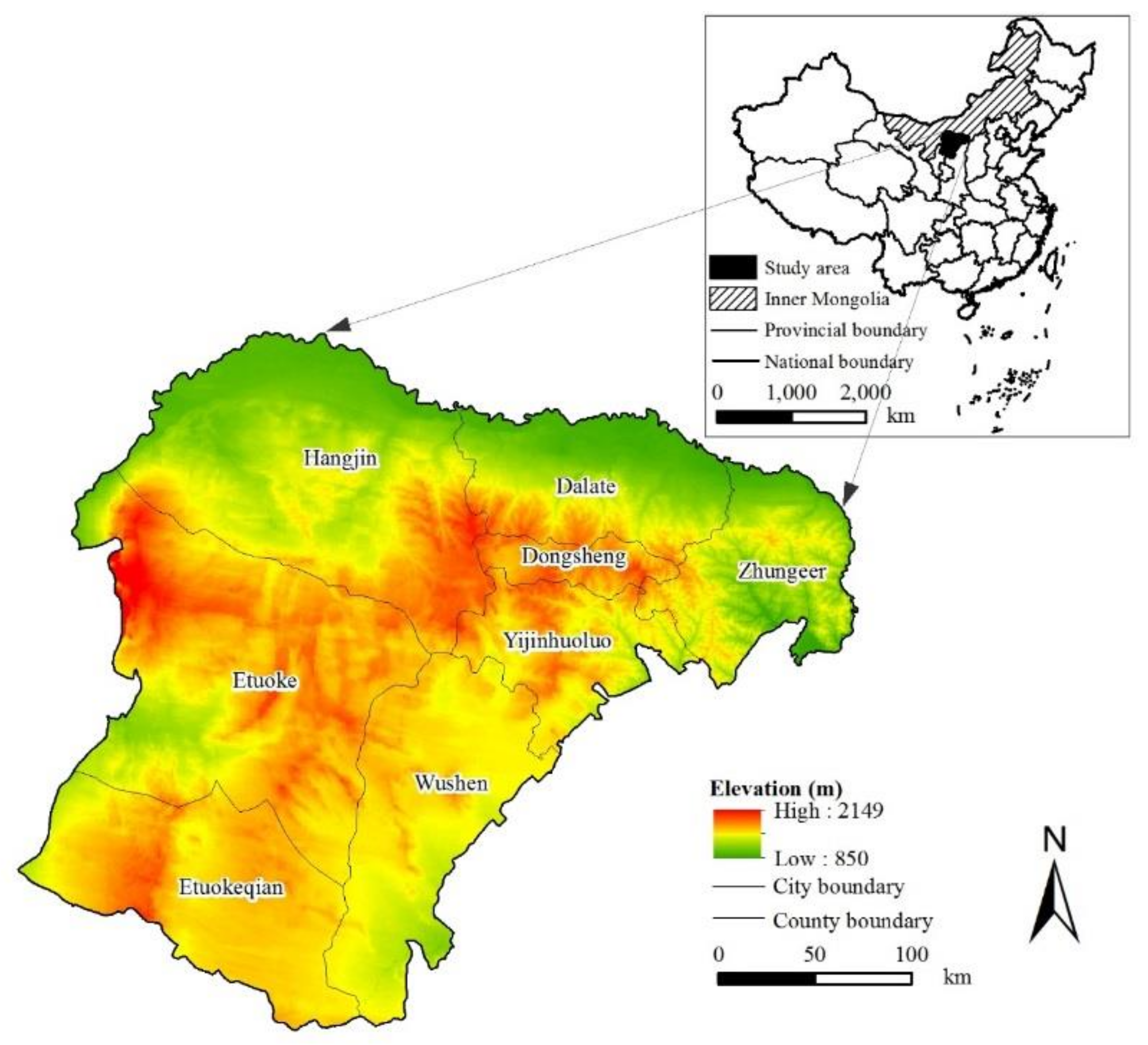

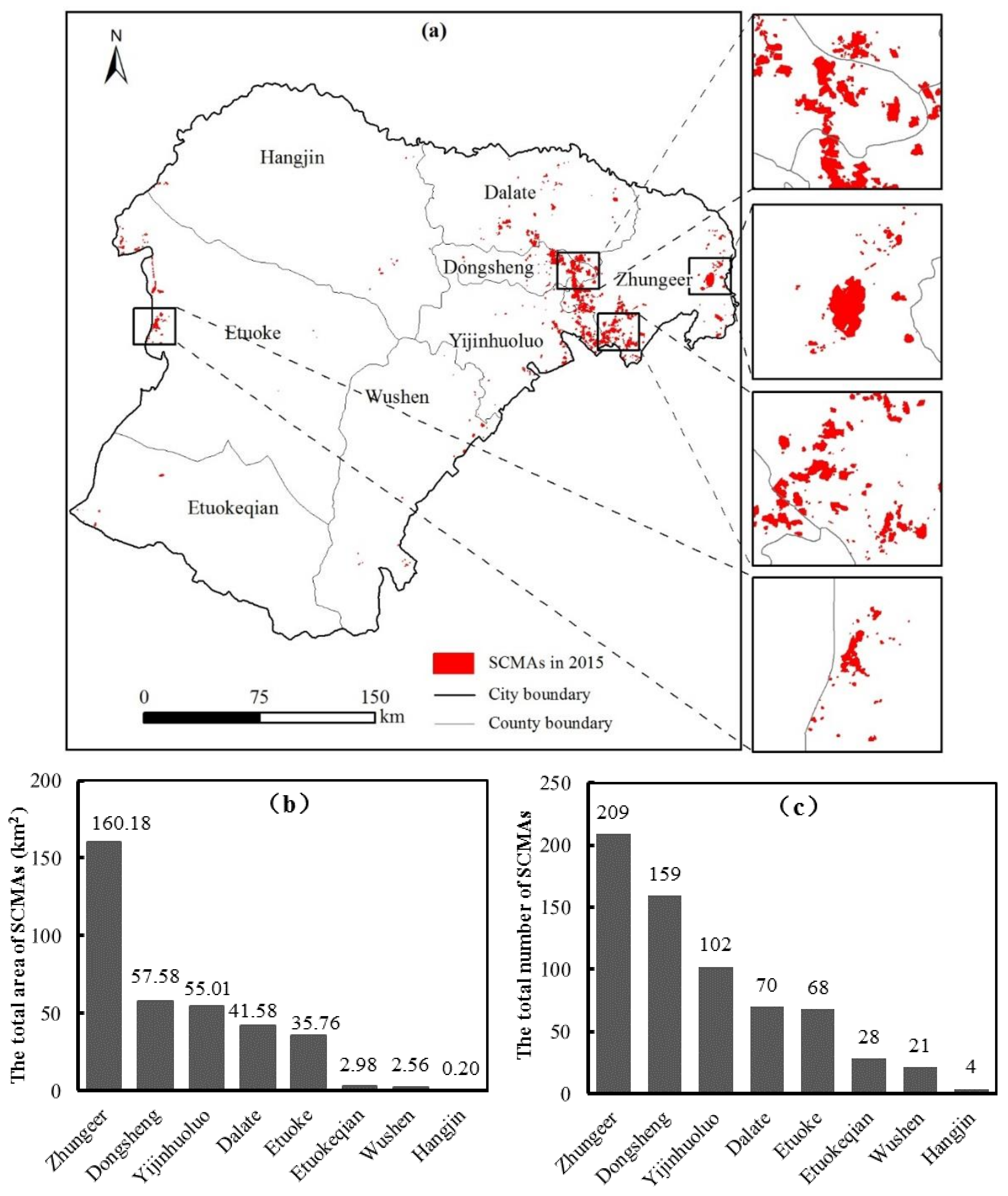
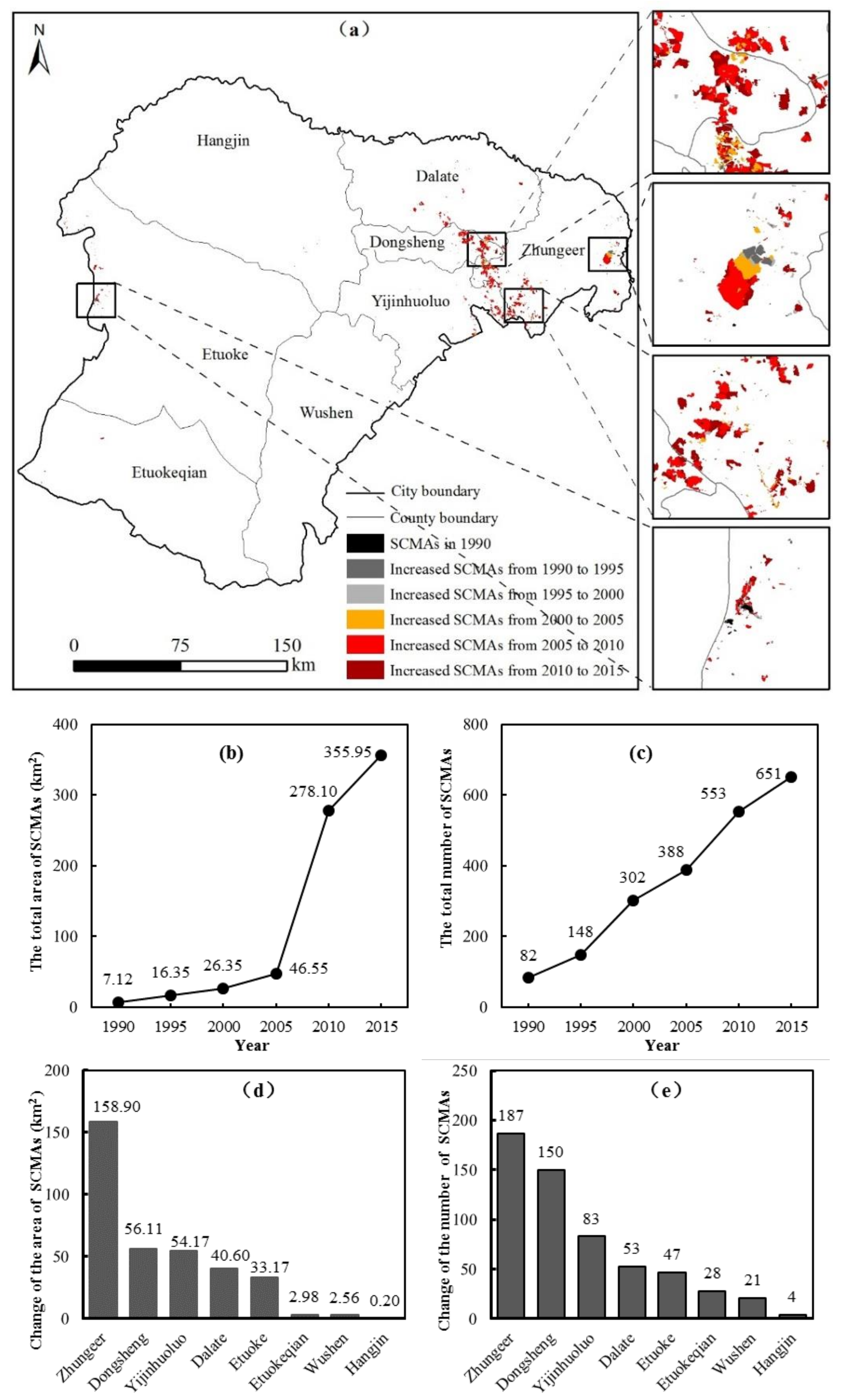
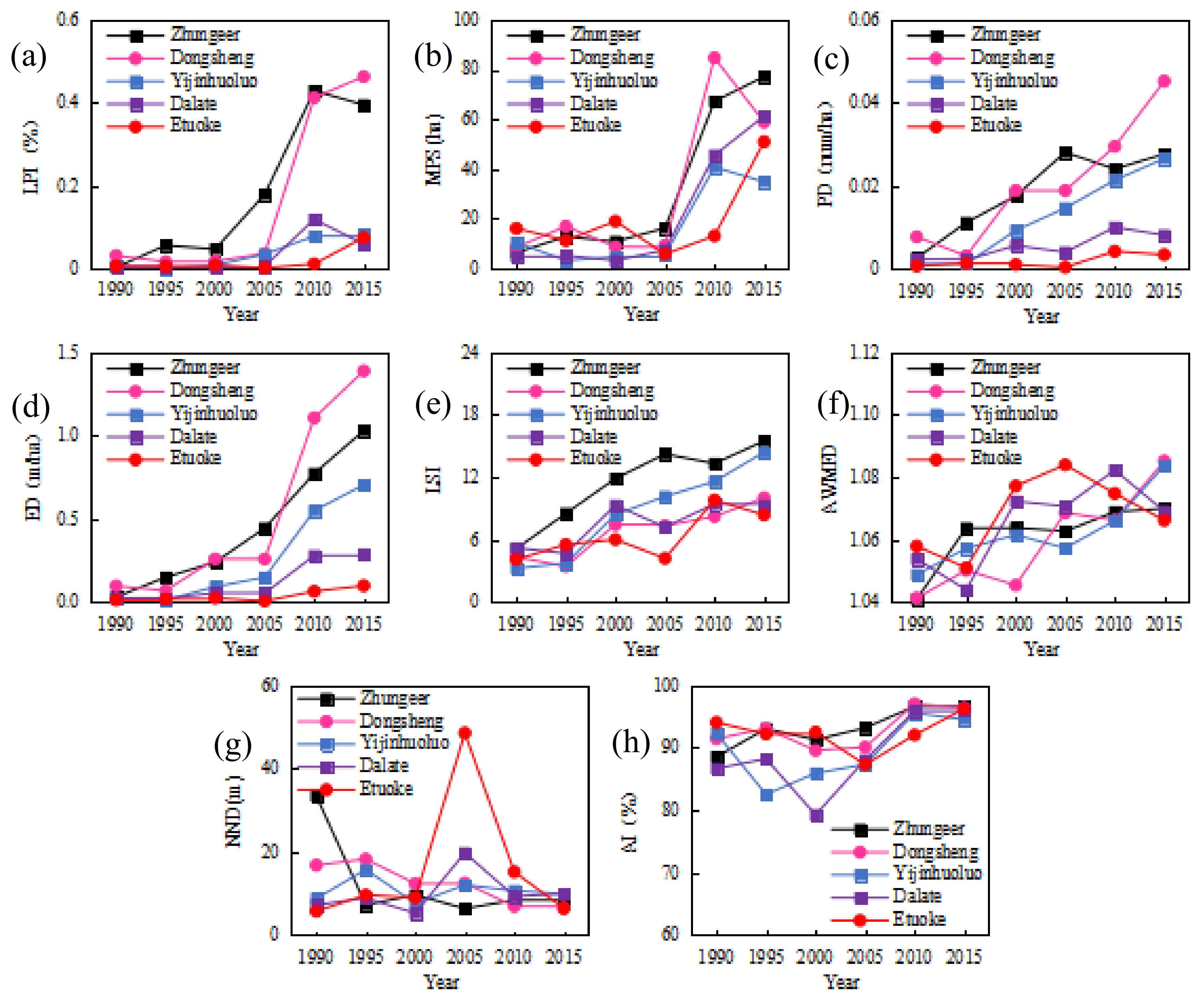
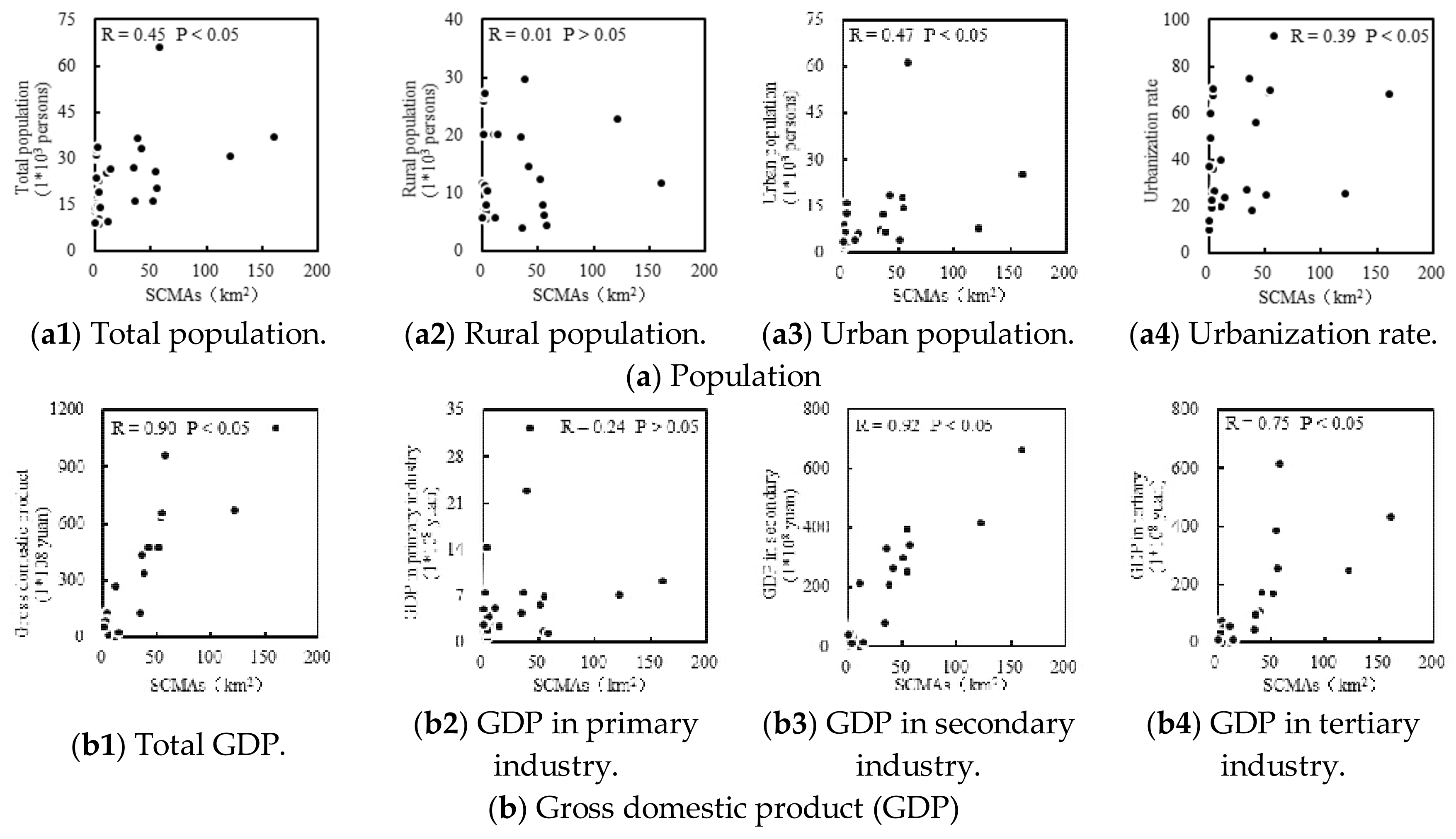
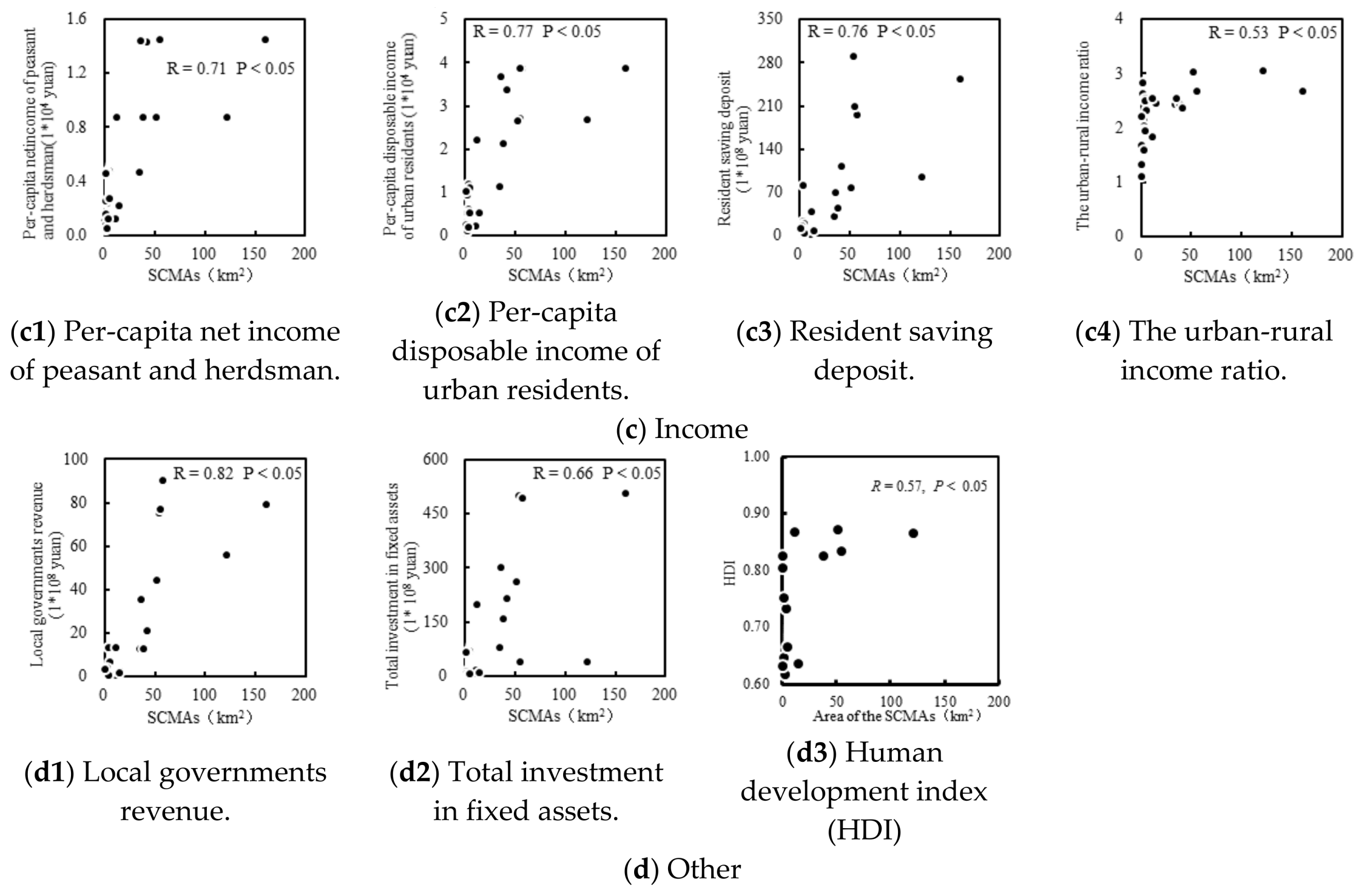
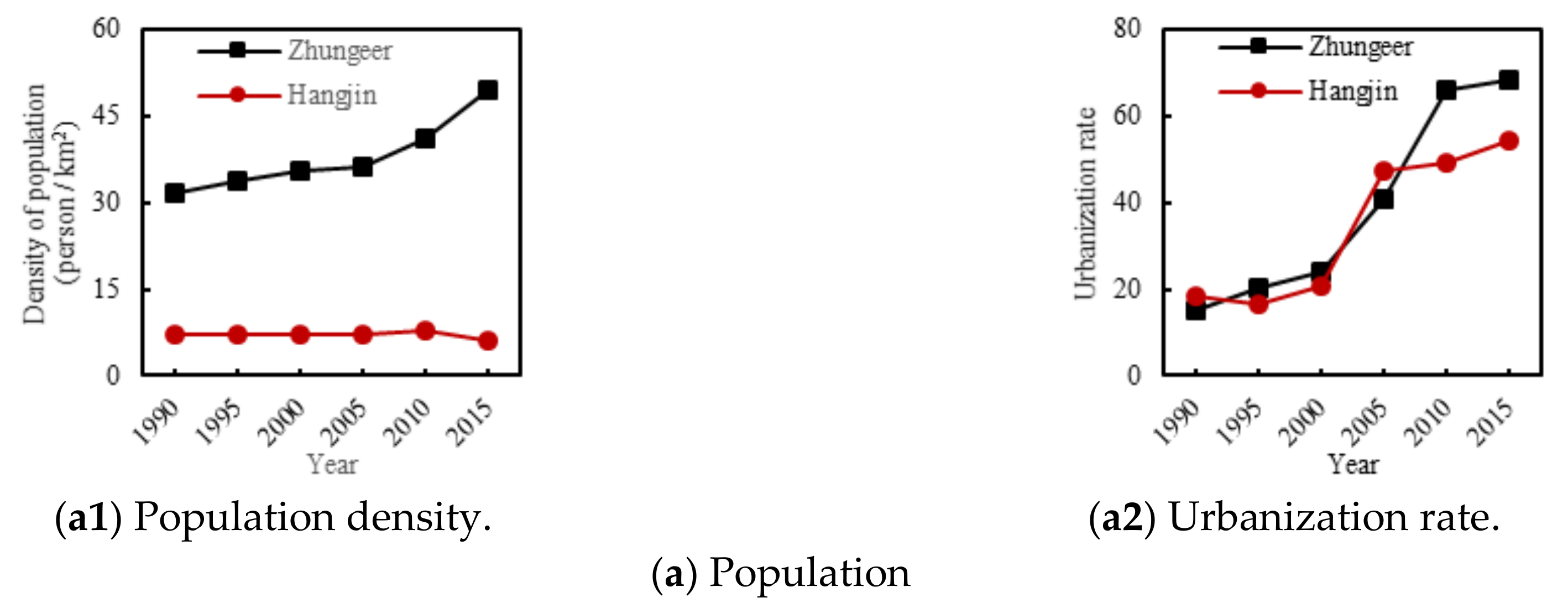
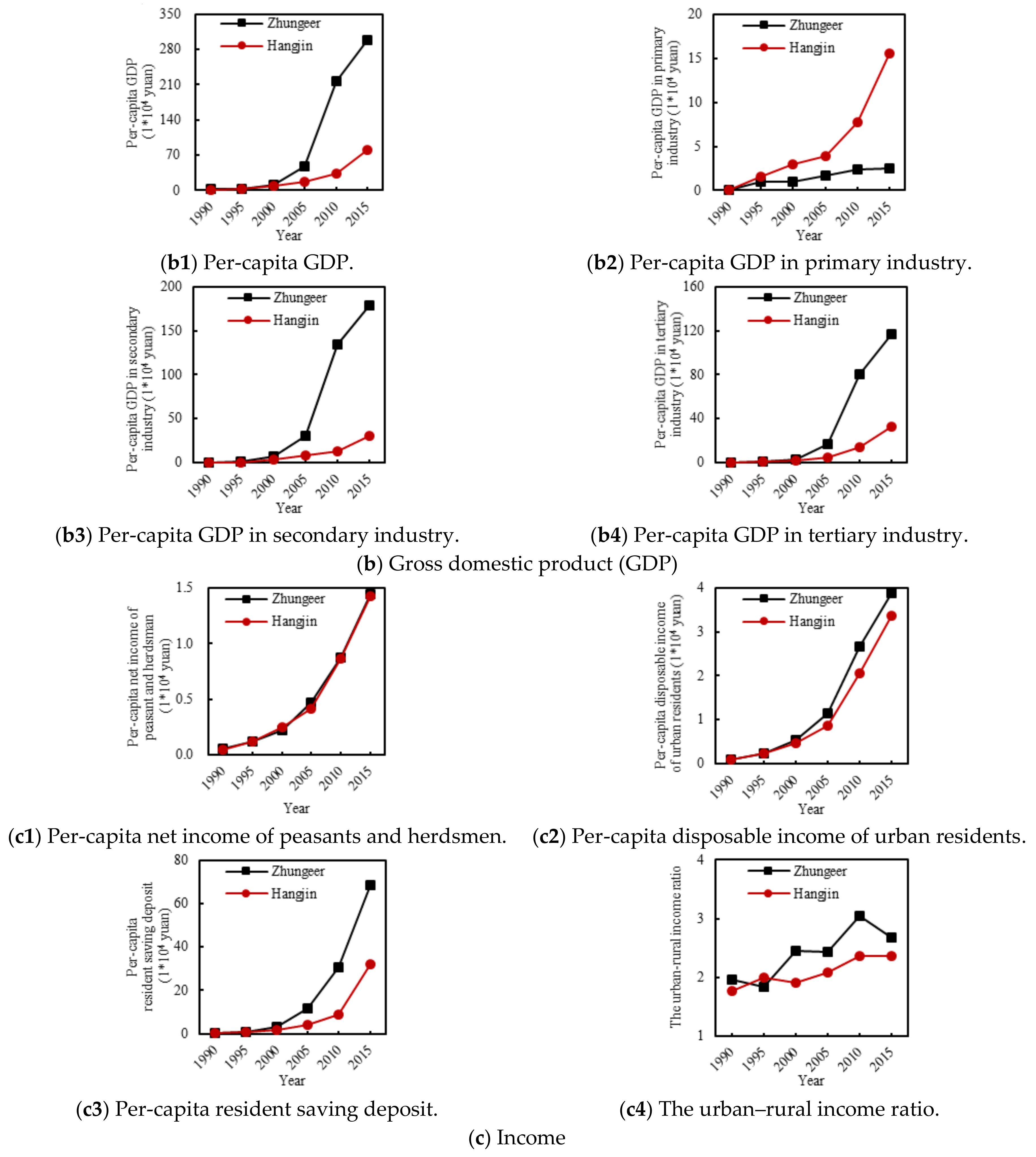

| Landscape Metric | Abbreviation | Description |
|---|---|---|
| Largest patch index | LPI | Largest patch index at the class level quantifies the percentage of total landscape area comprised by the largest patch (unit: %). |
| Mean patch size | MPS | The average area of all patches in the landscape (unit: ha). |
| Patch density | PD | The number of patches per hectare (unit: Number of patches/ha). |
| Edge density | ED | The total length of all edge segments per hectare for the class or landscape of consideration (unit: m/ha). |
| Landscape shape index | LSI | A modified perimeter-area ratio of the form that measures the shape complexity of patch. |
| Area-weighted mean fractal dimension | AWMFD | The patch fractal dimension weighted by relative patch area, which measures the average shape complexity of individual patches for the whole landscape or a specific patch type. |
| Mean Euclidean nearest neighbor distance | NND | The distance to the nearest neighboring forest patch, based on shortest edge-to-edge distance (unit: m). |
| Aggregation index | AI | Aggregation index is calculated from an adjacency matrix, which shows the frequency with which different pairs of patch types (including like adjacencies between the same patch type) appear side-by-side on the map. |
| Region/County | Area of SCMAs (km2) | Number of SCMAs | ||||||||||||||
|---|---|---|---|---|---|---|---|---|---|---|---|---|---|---|---|---|
| 1990 | 1995 | 2000 | 2005 | 2010 | 2015 | Change from 1990 to 1995 | Mean Annual Change Rate (%) | 1990 | 1995 | 2000 | 2005 | 2010 | 2015 | Change from 1990 to 1995 | Mean Annual Change Rate (%) | |
| Zhungeer | 1.28 | 10.83 | 14.58 | 34.34 | 121.51 | 160.18 | 158.9 | 21.31 * | 22 | 90 | 173 | 215 | 178 | 209 | 187 | 9.42 * |
| Dongsheng | 1.48 | 1.20 | 3.63 | 3.79 | 54.11 | 57.58 | 56.1 | 15.77 * | 19 | 9 | 48 | 41 | 65 | 102 | 83 | 6.95 * |
| Yijinhuoluo | 0.84 | 0.25 | 2.66 | 4.90 | 51.69 | 55.01 | 54.17 | 18.21 * | 9 | 8 | 59 | 87 | 122 | 159 | 150 | 12.17 * |
| Dalate | 0.97 | 0.97 | 1.66 | 2.54 | 38.26 | 41.58 | 40.61 | 16.22 * | 21 | 23 | 67 | 35 | 83 | 68 | 47 | 4.81 * |
| Etuoke | 2.59 | 3.24 | 4.22 | 0.64 | 11.35 | 35.76 | 33.17 | 11.07 * | 17 | 39 | 28 | 11 | 86 | 70 | 53 | 5.82 * |
| Etuokeqian | 0 | 0 | 0 | 0 | 0.24 | 2.98 | 2.98 | 65.50 ** | 0 | 0 | 0 | 0 | 9 | 21 | 21 | 18.47 ** |
| Wushen | 0 | 0 | 0 | 0 | 0.07 | 2.56 | 2.56 | 105.41 ** | 0 | 0 | 0 | 0 | 4 | 28 | 28 | 47.58 ** |
| Hangjin | 0 | 0 | 0 | 0.35 | 0.87 | 0.20 | 0.20 | −5.44 *** | 0 | 0 | 0 | 2 | 12 | 4 | 4 | 7.18 *** |
| Ordos | 7.16 | 16.50 | 26.84 | 46.55 | 278.10 | 355.86 | 348.7 | 16.91 * | 88 | 169 | 378 | 391 | 559 | 661 | 573 | 8.40 * |
| Region/County | LPI (%) | MPS (ha) | PD (num/ha) | ED (m/ha) | LSI | AWMFD | NND (m) | AI | |
|---|---|---|---|---|---|---|---|---|---|
| Zhungeer | 1990 | 0.00 | 6.34 | 0.00 | 0.03 | 5.13 | 1.04 | 3346.99 | 88.54 |
| 2015 | 0.39 | 77.06 | 0.03 | 1.03 | 15.48 | 1.07 | 815.07 | 96.56 | |
| Change | 0.39 | 70.72 | 0.03 | 1.00 | 10.35 | 0.03 | −2531.92 | 8.02 | |
| Dongsheng | 1990 | 0.03 | 8.58 | 0.01 | 0.10 | 4.33 | 1.04 | 1681.45 | 91.46 |
| 2015 | 0.46 | 58.82 | 0.05 | 1.39 | 10.03 | 1.09 | 652.94 | 96.42 | |
| Change | 0.43 | 50.25 | 0.04 | 1.29 | 5.69 | 0.04 | −1028.51 | 4.96 | |
| Yijinhuoluo | 1990 | 0.01 | 10.48 | 0.00 | 0.02 | 3.24 | 1.05 | 876.01 | 92.29 |
| 2015 | 0.08 | 34.82 | 0.03 | 0.71 | 14.41 | 1.08 | 991.62 | 94.55 | |
| Change | 0.08 | 24.34 | 0.03 | 0.68 | 11.17 | 0.03 | 115.61 | 2.26 | |
| Dalate | 1990 | 0.00 | 4.84 | 0.00 | 0.02 | 5.21 | 1.05 | 725.11 | 86.67 |
| 2015 | 0.06 | 61.20 | 0.01 | 0.29 | 9.30 | 1.07 | 993.46 | 96.11 | |
| Change | 0.06 | 56.36 | 0.01 | 0.26 | 4.09 | 0.02 | 268.34 | 9.44 | |
| Etuoke | 1990 | 0.01 | 16.13 | 0.00 | 0.01 | 4.10 | 1.06 | 573.86 | 94.05 |
| 2015 | 0.07 | 50.93 | 0.00 | 0.10 | 8.39 | 1.07 | 642.77 | 96.26 | |
| Change | 0.07 | 34.80 | 0.00 | 0.09 | 4.28 | 0.01 | 68.91 | 2.21 | |
| Ordos | 1990 | 0.00 | 6.97 | 0.00 | 0.03 | 9.06 | 1.05 | 1766.03 | 88.48 |
| 2015 | 0.12 | 60.29 | 0.02 | 0.73 | 24.46 | 1.08 | 831.05 | 96.03 | |
| Change | 0.12 | 53.32 | 0.02 | 0.69 | 15.40 | 0.03 | −934.98 | 7.54 |
| Categories | Class of Species | Name of Species | Population Trend | Habitat Loss Due to the Increased SCMAs (km2) |
|---|---|---|---|---|
| Critically endangered | Birds | Aythya baeri | Decreasing | 287.70 |
| Endangered | Birds | Falco cherrug | Decreasing | 287.70 |
| Endangered | Birds | Aquila nipalensis | Decreasing | 274.94 |
| Vulnerable | Birds | Otis tarda | Decreasing | 287.70 |
| Vulnerable | Birds | Haliaeetus leucoryphus | Decreasing | 287.70 |
| Vulnerable | Birds | Emberiza rustica | Decreasing | 287.70 |
| Vulnerable | Birds | Aquila heliaca | Decreasing | 287.70 |
| Vulnerable | Birds | Anser cygnoid | Decreasing | 287.70 |
| Vulnerable | Birds | Anser erythropus | Decreasing | 287.70 |
| Vulnerable | Birds | Pelecanus crispus | Decreasing | 284.80 |
| Vulnerable | Birds | Chlamydotis macqueenii | Decreasing | 264.31 |
| Vulnerable | Birds | Larus relictus | Decreasing | 0.00 |
| Vulnerable | Mammals | Vormela peregusna | Decreasing | 287.70 |
| Vulnerable | Mammals | Gazella subgutturosa | Decreasing | 269.71 |
| Vulnerable | Mammals | Naemorhedus griseus | Decreasing | 12.68 |
© 2018 by the authors. Licensee MDPI, Basel, Switzerland. This article is an open access article distributed under the terms and conditions of the Creative Commons Attribution (CC BY) license (http://creativecommons.org/licenses/by/4.0/).
Share and Cite
Zeng, X.; Liu, Z.; He, C.; Ma, Q.; Wu, J. Quantifying Surface Coal-Mining Patterns to Promote Regional Sustainability in Ordos, Inner Mongolia. Sustainability 2018, 10, 1135. https://doi.org/10.3390/su10041135
Zeng X, Liu Z, He C, Ma Q, Wu J. Quantifying Surface Coal-Mining Patterns to Promote Regional Sustainability in Ordos, Inner Mongolia. Sustainability. 2018; 10(4):1135. https://doi.org/10.3390/su10041135
Chicago/Turabian StyleZeng, Xiaoji, Zhifeng Liu, Chunyang He, Qun Ma, and Jianguo Wu. 2018. "Quantifying Surface Coal-Mining Patterns to Promote Regional Sustainability in Ordos, Inner Mongolia" Sustainability 10, no. 4: 1135. https://doi.org/10.3390/su10041135
APA StyleZeng, X., Liu, Z., He, C., Ma, Q., & Wu, J. (2018). Quantifying Surface Coal-Mining Patterns to Promote Regional Sustainability in Ordos, Inner Mongolia. Sustainability, 10(4), 1135. https://doi.org/10.3390/su10041135






